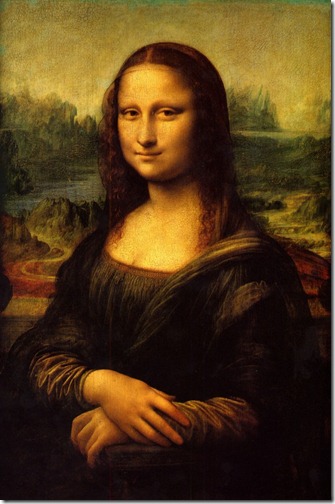Tales of La Gioconda–Part 1 Posted by Geoff on Apr 20, 2012 in Uncategorized
It’s probably the world’s most famous painting, millions of us have been to visit it in the Louvre, and just about everyone will have seen it reproduced as a print, postcard, chocolate box lid, tea cosy, etc. ad infinitum. But how many of us have found ourselves standing amongst the constant crowd of pilgrims that gather before Leonardo’s famous portrait and have said to ourselves: ‘So what, why all the hype?’ Well, even if Monna Lisa doesn’t really excite you it certainly is an extremely interesting and important painting, and in order to appreciate why, we need to understand two key pioneering techniques developed by Leonardo which, once you know what to look for, are so evident in La Gioconda.
Prospettiva Aerea – Aerial Perspective.
Have you ever considered how our brains perceive our environment? Well, Leonardo certainly did, and he made close observational studies of nature in order to discover how he could ‘trick’ us into believing that a two dimensional representation of nature, a portrait of a lady for example, could actually have depth and space. He wanted to make us believe, in other words, that we are looking ‘into’ the painting rather than just ‘at’ it.
Leonardo’s observations taught him that when we look at a landscape, objects that are farther away from us appear more hazy and indistinct. In addition to this, distant object appear more bluish in tone. This phenomena, known as prospettiva aerea, is due to the fact that air isn’t really transparent, it contains moisture and dust, and therefore the ‘thicker’ the air between us and the object that we are observing the less clearly it will appear to us. Leonardo imitated this effect of nature in his paintings, and if you now take another look at La Gioconda you will see how successfully it works. Our senses of perception tell us that Lisa is sitting in front of a distant landscape, even if logically we know that we are staring at a two dimensional surface, and that there is no ‘in front of’ or ‘behind’. Leonardo was the true pioneer of aerial perspective, and his innovative technique was quickly taken up by other artists until it became standard practice.
Sfumato – Blurred
The second great innovation developed by Leonardo is the technique known as sfumato. Look carefully at Lisa’s famous enigmatic smile, paying particular attention to the corners of her mouth and eyes. Note how the lines are blurred and indistinct, creating the impression that the more you stare at her face the more it seems to transform before your eyes, almost as if it were alive. Leonardo’s powers of observation, coupled with his profound insights into human perception, taught him how to leave key features of his subject hazy and indistinct in order to create the illusion of movement and life. Once again we are tricked into believe that an inanimate two dimensional surface has a life of its own.
Stay tuned for part 2 of ‘Tales of La Gioconda’

Build vocabulary, practice pronunciation, and more with Transparent Language Online. Available anytime, anywhere, on any device.





Leave a comment: